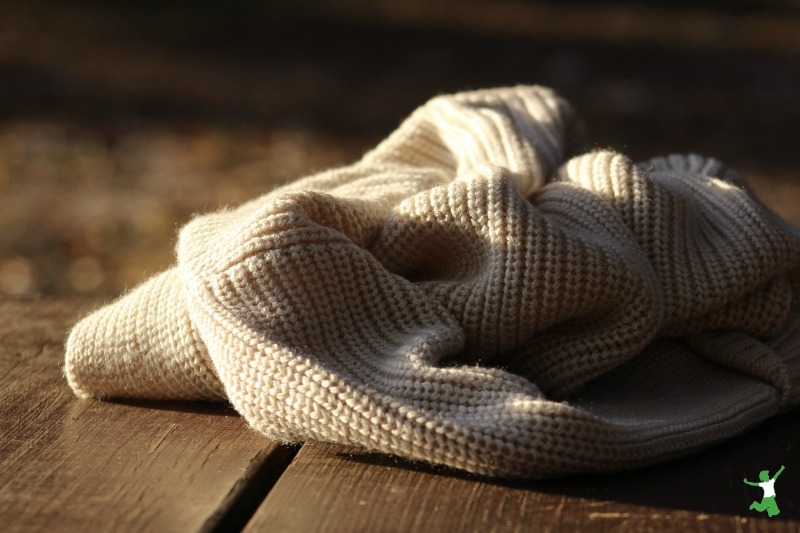The easy process for making homemade filters that are washable and simple to keep clean and germ-free to keep you breathing freely all year long.
Snow is falling, cold wind is blowing. The furnace clicks on.
Uh oh!
What about all that dust and dirt and who knows what else that has collected in the air ducts over the past months?
Here’s a simple solution for keeping the dusty and even moldy muck from spewing into your air and into your lungs when you breathe.
Make your own washable homemade filters!
How to Make Healthy, Homemade Filters
Find an old 100% wool sweater; perhaps at your local Salvation Army and wash it in hot, hot water and simple soap in your washing machine. This is not a time to worry about the delicacy of the sweater. We want it to felt up good and thick, even shrink.
The idea is to tease the fibers into felty submission. Then dry it in a hot dryer. This will further the felting process. Once the sweater is thick and misshapen, measure the perimeter of the register (the opening on the floor where the heat blows out) and cut the sweater to fit neatly into the opening.
The best part is that you don’t need to hem the ends since felted wool doesn’t fray.
It will make a tidy homemade filter that allows the free flow of hot air while offering a hygienic filter.
These homemade filters are as good, if not better, than any pre-made filters from the store and are easily tossed into the washer monthly, so you and your family can breathe freely and not spend a dime!
When the furnace first comes on in the cooler months, clean the filters more often, perhaps even have a few of them already made and fitted.
In your little girl’s room, choose a pink sweater. In your son’s, blue. Homemade filters can color coordinate too!
Simple solutions for a healthier life … made by you.
Our health is in our hands!
For more information on clean indoor air, this article explains the top 10 house plants proven by NASA to filter toxins out of the air that outgas from building materials and household products.









HELLO, OLD PANTYHOSE WITH NO HOLES WORKS EVEN BETTER. THEY DO GET DUSTY PRETTY QUICK SO EVERY MONTH FIND ANOTHER PAIR TO USE. YOU CAN WASH THEM BUT ALL THE DUST DOESNT ALWAYS COME OUT.
My intake vents are in the ceiling. There is no place to put a filter. now what?
i tried this and the sweater ended up becoming far too thick not letting any air through. BAD IDEA!!!
Neat idea! After all these years, how are the wool / felted filters holding up? Have you needed to replace them?
You may be having a bad air day every day — and we are not talking about outdoor air. The indoor air quality in your home may be affecting your health and the health of your family members.
“Indoor air quality can be worse than outdoor air quality in almost every case,” says William J. Calhoun, MD, professor of medicine and vice chair of the department of medicine at the University of Texas Medical Branch in Galveston.
Cheesecloth allows more air to move through but still catches plenty of dust etc. It’s easy to cut to size, you can make it as thick or thin as needed, too. If you put filters on the cold air return vents as well, it keeps the dust/pet dander etc from going back into the system.
Why would putting the “sweater” filter in the vent opening cause any more strain on the blower motor that closing the register vent would?
If you close one vent, the air pressure flows to the other vents; no big deal and the pressure generally gets equalized elsewhere in the system without affecting the blower.
If you cover all vents in your home, but still run the blower, the blower is going to at the very least run longer and worst case scenario will be operating under substantial back-pressure (very bad for the blower).
Generally speaking, you just want to make sure that if you’re covering your vents with something, that they still permit good air-flow. This is the same reason that some of the “better” air filters that go into your units can actually wear your furnace blowers out faster, or up your heating bills. Also the same reason you’ll have a higher bill if you don’t change your filter often enough. Built up dust prevents air-flow, creating back-pressure in the system and hindering performance.
Unless you’re packing these wool filters in really tightly though, you’re not likely to see much difference in the performance of your furnace. Just remember that choosing a good furnace filter, and changing it regularly, is still important when using these (this method is supplemental, not a replacement).
I am going to side with the HVAC technicians on this one (I’m not a HVAC person). This does not sound like a good idea because it will put strain on your blower motor in your furnace. While I just love the ingenuity of this idea, I don’t think it is a good idea for the health of the furnace. They’re very expensive to replace. I’m not sure the cost of just the blower motor, but why spend lots of unnecessary $$$ to replace one because the motor burned out early?
If you want cleaner air in your home, here are 3 safer ways to do this:
* Use good quality furnace filters and check or replace them every 3 months. If you see lots of dirt/dust, replace with a new one, if not check again in 3 months. These are the square or rectangular filters that go inside your furnace. This is probably the most effective thing you can do to clean your air in your home AND keep your furnace functioning properly. Any of the pleated style filters work well, avoid the loose fiber kinds. 3M makes some of the best ones, but are overrated, in my opinion. Store branded pleated filters work nearly as well as the more expensive 3M ones. This tip is a “must do”, whereas the following two tips are optional. If you don’t change your furnace filter regularly, you’re circulating dusty air through your home as well as putting undue stress on the furnace itself.
* Have your ductwork cleaned professionally every couple of years. Costs run around $200-$400 for a quality clean job, depending upon your location. This is more important if you have pets, because pet dander will fall down into the vents (if the vents are on the floor) and will get blown back out next time the heat or AC comes on.
* use an air filter machine in the rooms you most frequent, or simply move one machine around to a different location every few days. HEPA based filter machines clean the best, but even a cheap filter machine will do a lot of good cleaning the air. A bigger machine can generally clean more air with less noise. Check filters every 3 months when you check the furnace filters.
Now, I do believe there are WASHABLE furnace filters, but I have not used them. I think your furnace must also be designed to work with them. Perhaps someone knows more about these than I do. My general experience with washable filters (vacuums, etc) is they sound better on paper than they work in real life.
I like this idea. I don’t think it would make the furnace run hot, nor do I think it would burn up the motor. I think the wool sweater is a great idea and one that the next time I am out and about, I will look for just the right sweater to do this with. WOW, no dust, that would be a great thing in our old house. LOL
What about baseboard heat?
I had to reread the article. Note that it is not ‘furnace filters’ but the ‘floor registers’ in each room. I can understand the mix-up because I misunderstood as well. 🙂